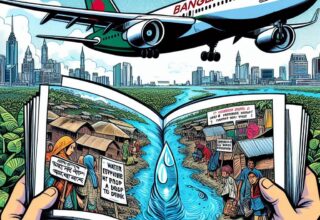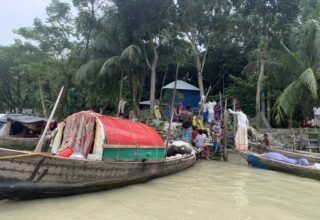This blog is part of ICCCAD Blog Series for World Environment Day 2020. It briefs on the legal frameworks undertaken for conserving biodiversity since the 1990s along with the crucial relationship between Sustainable Development Goals (SDGs) and the Convention on Biological Diversity (CBD). In addition, it also sheds light on biodiversity from international to national as well as local perspective.
What is Biodiversity
“Biological diversity” is often shortened to “bio-diversity” that has won the central point of development policy debates since decades. The rights and responsibilities for conserving biodiversity have been shaped up with the adoption of the Convention on Biological Diversity (CBD), which is considered as a milestone of natural resources management and environment. The conservation and utilization of biodiversity has increasingly become a great challenge at national and international level as well, which also raised the fundamental question, that being a part of nature itself whether we human being have the right to destroy the species and ecosystems. “Biodiversity” is an umbrella term used to describe the number, variety, variability among living organisms from all sources including inter alia, terrestrial, marine and other aquatic ecosystems and the ecological complexes of which they are part. It includes diversity within species, between species and the variability of life in all forms, levels, and combinations. The study on earth species published in the journal PLoS Biology in 2011 estimates that the planet earth is now home for 8.7 million species, which is the most accurate yet, but only a tiny proportion is known to science till date.
The UNFCCC Paris Agreement on climate change, adopted in 2015, referred the word “biodiversity” in its 32 pages, while “Forests” appears a few times, but “oceans”, like biodiversity, scores just a single appearance. Apparently, what does the Paris agreement mean for the world’s other 8.7 million species whose survival is equally crucial for the survival and wellbeing of human? The paradox of whole cost-benefit analysis became evident during the current Covid-19 crisis to have a balance for co-existence of human, nature and ecosystem.
Legal instruments for Biodiversity
On May 1992, in Nairobi, the nations of the world adopted the global Convention on Biological Diversity that is a historic commitment of the world to conserve and sustainable use of biodiversity. It is the first time the conservation of biodiversity is recognised as the common concern of humankind. “Common concern” implies a common responsibility to the issue based on its paramount importance. Later, on 5th June 1992, at the “Rio Earth Summit”, a record number of over 150 States signed the convention. The Convention entered into force on December 1993. Bangladesh has ratified the convention on 20th March 1994.
The CBD, in many contexts, have gone beyond the conventional approach of conservation of biodiversity per se. The sovereign rights of the States over their natural resources are referred to in the preamble of CBD and twice in the main text. Agenda 21 of the Stockholm Declaration recognised that States have the sovereign right to exploit their own resources pursuant to their own environmental policies and laws.
Emphasis has given for in-situ and ex-situ conservation with the obligation which constitutes a comprehensive agenda and calls for measures ranging from the establishment of a system of protected areas to the rehabilitation of degraded ecosystems and recovery of threatened species, the protection of natural habitats and the maintenance of viable populations of species in natural surroundings. The role of indigenous and local communities in conserving biodiversity and the importance of maintaining traditional knowledge and practices are recognised. It also acknowledged and given recognition to the vital role that a woman plays in the conservation and sustainable use of biodiversity. The convention sets out the balance between fair access and equitable benefit sharing. This is the heart of the political agreement upon which the Convention is founded.
Cartegana Protocol on Biosafety:
The Conference of the Parties to the CBD adopted a supplementary agreement to the Convention known as the Cartegana Protocol on Biosafety on 29th January 2000. It seeks to protect biological diversity from the potential risks posed by living modified organisms (GMOs) resulting from modern biotechnology. The Protocol also establishes a Biosafety clearing house mechanisms to facilitate the exchange of information on living modified organisms and to assist countries in the implementation of the Protocol.
Other International Agreements related to Biodiversity:
A number of conventions now in force those address various aspects of biodiversity conservation: The Convention on Wetlands of International Importance Especially as Waterfowl Habitat (Ramsar, 1971), International Convention for the Protection of Birds (Paris 1950), International Plant protection Convention (Rome 1951), The Convention concerning the protection of the world cultural and national heritage (Paris, 1972), The Convention on International Trade in Endangered Species of wild fauna and flora (Washington, 1973), The Convention on the conservation of migratory species of wild animals (Bonn, 1979) etc. Also a new treaty on agricultural biodiversity “Treaty on Plant Genetic Resources for Food and Agriculture” was adopted by the FAO Conference in Rome in November 2001. In November 2003 Bangladesh has ratified the treaty. This is the first effort to establish a formal legal framework for plant genetic resources for food and agriculture.
Sustainable Development Goals (SDGs) and CBD:
The conservation, restoration and sustainable use of terrestrial ecosystems are essential to attain the key objectives of sustainable development. The Sustainable Development Goal 15 of the 2030 Agenda for Sustainable Development is devoted to “protect, restore and promote sustainable use of terrestrial ecosystems, sustainably manage forests, combat desertification, and halt and reverse land degradation and halt biodiversity loss”.
At the Rio+20 Conference, Member States reaffirmed, through paragraphs 197- 204 of the outcome document, the Future We Want, that “intrinsic value of biological diversity, as well as the ecological, genetic, social, economic, scientific, educational, cultural, recreational and aesthetic values of biological diversity and its critical role in maintaining ecosystems that provide essential services, which are critical foundations for sustainable development and human well-being”.
The Strategic Plan for Biodiversity 2011-2020 and its Aichi Biodiversity Targets adopted under the Convention on Biological Diversity has been recognized as setting the global framework for priority actions on biodiversity. The SDGs and the Strategic Plan are mutually supportive and reinforcing, and implementation of one contributes to the achievement of the other.
Biodiversity in Bangladesh National Legislation:
The national legislation of a country ultimately has a very important role in conserving biodiversity, sustainable use of nature and environment and preventing environmental degradation. “Article 18(a) of the Bangladesh Constitution makes the state responsible for the protection of biodiversity. This is an obligation on our part. Besides, Bangladesh is a signatory to the international agreement, ‘Convention on Biological Diversity’, committing us to biotic reservation.” The law that comprehensively deals with environment conservation is the Bangladesh Environment Conservation Act (BECA), 1995. Section 5 of the BECA, 1995 has authorised the Govt. to declare areas of great ecological importance as Ecologically Critical Area (ECA). The then Ministry of Environment and Forest (MoEF) declared 7 areas as ECA by a notification: Sundarbans (Entire area declared as reserve forest.), Cox’s Bazar Teknaf beach, Sonadia Island, Hakaluki Haor, Tangua Haor, St. Martins Island and Marjat Baor. Later Gulshan Baridhara lake was also added to the list as ECA.
The country also adopted ‘Bangladesh Biodiversity Act-2015’ which was later published in the gazette as the Bangladesh Biodiversity Act, 2017 (Act No. II). We also have the Biodiversity and Community Knowledge Protection Act which aims to implement the spirit, principles and relevant provisions of the Convention on Biological Diversity. Both the Acts aims to protect the sovereign rights of the communities that have knowledge of biodiversity, and have managed, maintained, conserved, reproduced and enhanced biodiversity, genetic resources and traditional knowledge, culture and various forms of practice related to these resources. Various National policies like Environment Policy (1992), Water Policy (1999), Policy on Fisheries (1998), Policy on Fisheries (1998), National Forest Policy (1994) adopted by the Govt. of Bangladesh are somehow related for the conservation of biodiversity.
The Local People and Biodiversity:
The lives and livelihoods of the local people of Bangladesh are mostly dependent on environment and thus are affected predominantly by the environmental policies, laws and agreements. The rights of the local people to live in a sound environment in each step are inherently linked with the natural rights over biodiversity. But unfortunately the linkages between environmental policies, laws and regulations and the way local people acts, thinks are missing. The laws and policies do not always necessarily reflect the voice and conservation ethics of the local people. Apparently, there is little thrust for searching local believes and customs they are practising from ancient times as the main custodians of their natural resources. Localisation (Sthaniokoron) and socialisation (Samajikikoron) of Biodiversity related policies, laws and agreements are needed by respecting local peoples’ own socio-cultural norms and values, by better understanding of social network and local legal advocacy system. Legal mechanisms and policy option must ensure the participation of not only a certain group of local people but the entire community to be involved in policy formulation, implementation, research, access-benefit sharing for conservation, improvement and better use of biodiversity as they are the key stakeholders of the biodiversity regime.
About the Author:
Shaila Shahid is the Senior Advisor on Climate Change, Gender and DRR at ICCCAD and Zakir Md. Hossain is Founder and the Chief of Krisoker Sor (Farmers’ Voice)






